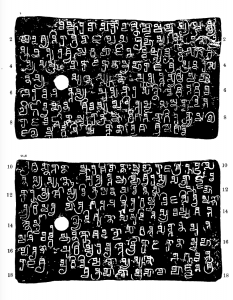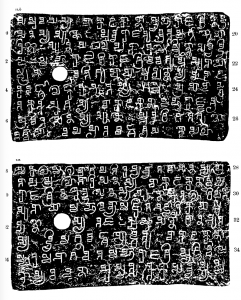

The charter consists of five plates, but only three bear inscription and the attached seal is also without inscription. According to Shastri 1997: 70, this indicates that the charter was left unfinished. Mirashi 1963: 79 also states that the charter was left incomplete as it does not specify the donation. It does however record the planned place of issue, Pṛthivīṣeṇa II’s temporary residence at Vembāra, which Mirashi 1963: 80 has identified with the modern village of Bembāl, 28 miles east of Chandrapur and 2 miles west of the Waingaṅhā river. Although incomplete, the importance of the inscription lies in its mention of Pṛthivīṣeṇa II and his father Narendrasena II. Prior to the discovery of this charter, neither ruler was known as only grants of Pravarasena II were known before 1893. Because of this, the description of both Narendrasena II, Pravarasena II’s son (?) and Pṛthivīṣeṇa II were new contributions to the known Vākāṭaka history.
From the camp fixed at Vêmbâra―
By the order of the illustrious Prithivîshena (II), the Mahârâja of the Vâkâtakas; who is a devout worshipper of Bhagavat (Vishnu), who has rescued his sunken family; who is the abode of valour and forgiveness, who was born of the MahâdêvîAjjhitabhattârikâ, the daugther of the lord of Kuntala; who is the son of the illustrious Narêndrasêna, the Mahârâja of the Vâkâtakas, who held in check enemies bowed down by his valour, whose commands were honoured by the lords of Kôsalâ,Mekalâ, and Mâlava; who, from confidence in the excelence qualities previously acquired by him, took away the (royal) fortune of (his) family; who was the son of the illustrious Pravarasêna (II), the Mahârâja of the Vâkâtakas
(For translation lines 1-25, see above, pp 13-14)
(Line 35) Our [officers of noble birth] appointed by the Sarvâdhyaksha (General Superintendent)
(The subsequent portion of the grant was not inscribed)